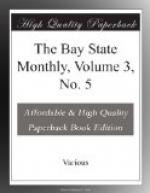[Illustration: WINDSOR HOTEL.]
The total area of Holyoke is about fourteen square miles. The first city government was organized in January 1874, and the first Mayor of the city was Hon. Wm. B.C. Pearsons, now judge of the Police court, who held the office three years. The succeeding mayors have been Hon. William Whiting, at present a Congressman from the 11th District, R.P. Crafts, William Ruddy, F.P. Goodall, and James E. Delaney, the present Executive. The city offices and the public library are located in the city hall, a fine granite building which was completed in 1876 at a cost of nearly $400.000. In the same year the city erected a monument on Hampden Square in memory of the soldiers who died in the war of the Rebellion. The handsome open house, where the best of theatrical and musical talent appears during the entertainment season, was built by Messrs Whiting & Brown and was completed in 1878.
The city has four National Banks, and three Savings Banks. It has a daily newspaper, the Transcript, which is the direct successor of the first newspaper printed in Holyoke, in 1849. Under its present title the Transcript has been published since the year 1863.
The water supply for the city is derived from the Ashley and Wright ponds, the water-works having been completed in 1873. Since then, other mountain streams and reservoirs have been united with the water supply of the ponds, to make it adequate for the growing city’s needs. The ponds from which the pipes are laid are located some four miles from the City hall.
Holyoke pays liberally to support its public schools. There are eight brick school buildings with all the modern improvements and conveniences for the graded schools, besides suburban school houses and a High school with 160 pupils. The Catholic parishes in the city also support flourishing parochial schools, St. Jerome parish having just completed a huge brick building for a girl’s school.
The city has a wealth of new churches. The first little square white church which the Baptists built in the beginning of the century was removed in 1880 and a modern brick church now occupies the site. The Second Baptist Church society in the central part of the city has just completed a fine church edifice. The Second Congregational society, two years ago, dedicated a splendid granite building which cost nearly $100,000, the successor of the plain brick meeting-house which in 1853 was erected at the corner of High and Dwight streets. The city has a large Catholic population and three extensive Catholic parishes each having a capacious church of fitting architecture. The Episcopal people worship in a picturesque stone church on Maple street, and near it is the cozy little Unitarian church. The Methodists built a church of brick on Main street about the year 1870. The First Congregational society has a wooden edifice on Northampton street—the oldest church building in the city since the primitive First Baptist meeting-house was taken down—and the church at South Holyoke where the German residents listen to the services of their faith in the language of the fatherland.




